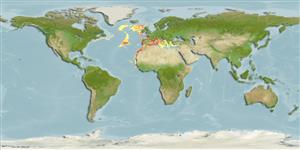Actinopterygii (ray-finned fishes) >
Aulopiformes (Grinners) >
Ipnopidae (Deep-sea tripod fishes)
Etymology: Bathypterois: Greek, bathys = deep + Greek, pterois = with wings (Ref. 45335). More on author: Vaillant.
Issue
Bathypterois mediterraneus (considered as a synonym) may be valid.
Environment / Climate / Range
Ecology
Marine; bathydemersal; depth range 260 - 2800 m (Ref. 3397), usually 2100 - 2300 m (Ref. 32939). Deep-water, preferred ?; - 6°S
Eastern Atlantic: northeast Atlantic to off Sierra Leone; one record from the Mediterranean. One record from the northwest Atlantic.
Size / Weight / Age
Maturity: Lm ? range ? - ? cm
Max length : 20.5 cm SL male/unsexed; (Ref. 3590); 20.4 cm TL (female)
Found on continental slope and rise between temperatures of 12°C to 4°C (Ref. 3590). Usually solitary; probably forms occasional aggregates. Feeds on mysids and benthopelagic copepods. Synchronously hermaphroditic (Ref. 6688).
Life cycle and mating behavior
Maturity | Reproduction | Spawning | Eggs | Fecundity | Larvae
Merrett, N.R., 1990. Chlorophthalmidae. p. 351-360. In J.C. Quero, J.C. Hureau, C. Karrer, A. Post and L. Saldanha (eds.) Check-list of the fishes of the eastern tropical Atlantic (CLOFETA). JNICT, Lisbon; SEI, Paris; and UNESCO, Paris. Vol. 1. (Ref. 3590)
IUCN Red List Status (Ref. 115185)
CITES (Ref. 94142)
Not Evaluated
Threat to humans
Harmless
Human uses
More information
ReferencesAquacultureAquaculture profileStrainsGeneticsAllele frequenciesHeritabilityDiseasesProcessingMass conversion
Tools
Special reports
Download XML
Internet sources
Estimates of some properties based on models
Phylogenetic diversity index (Ref.
82805): PD
50 = 0.5000 [Uniqueness, from 0.5 = low to 2.0 = high].
Bayesian length-weight: a=0.00490 (0.00193 - 0.01241), b=3.03 (2.81 - 3.25), in cm Total Length, based on LWR estimates for this (Sub)family-body shape (Ref.
93245).
Trophic Level (Ref.
69278): 3.4 ±0.45 se; Based on food items.
Resilience (Ref.
69278): Medium, minimum population doubling time 1.4 - 4.4 years (k=0.13-0.4).
Vulnerability (Ref.
59153): Moderate to high vulnerability (52 of 100) .
